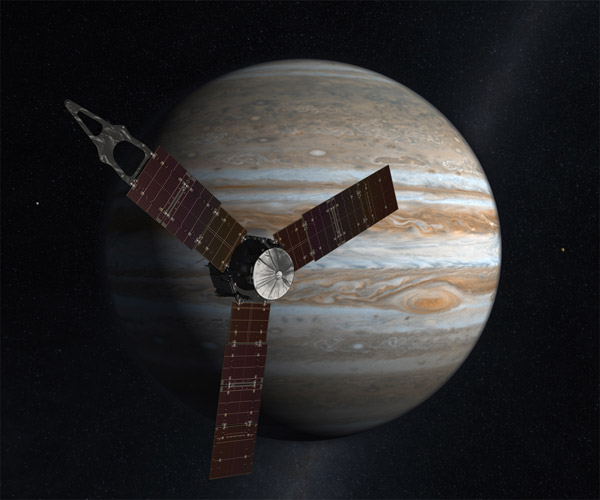26 April 2011
Planetary Origins and Evolution: An Interview with David Stevenson
Posted by Michael McFadden
This post is the second of a series of profiles on planetary scientists by Mark Hilverda, geoscientist and web manager for AGU’s Planetary Sciences Section. A more complete version of this interview that includes a list of reading resources was published on the recently revamped Planetary Sciences website.
David Stevenson is the George Van Osdol Professor of Planetary Science at the California Institute of Technology. He researches internal structure and evolution of both major and terrestrial planets, application of fluid dynamics and magnetohydrodynamics [dynamicsof electrically conducting fluids] to planetary interiors, and the origin of the solar system. Mark Hilverda recently caught up with him to discuss his early career, his thoughts on the best way to send a probe to the Earth’s core, and his involvement with the upcoming Juno mission to Jupiter, among other topics.
Every person seems to enter the field of planetary science via different avenues. How did you first become interested in planetary science?
As a high school student and even as an undergraduate in New Zealand, I was unaware that planetary science existed as a career. It seemed more like a hobby. I knew about the Apollo program, of course, but the kind of science possible with Apollo did not appeal all that much when I was young — I appreciate it much more now. When it came time to decide where to go for graduate work, I had no doubt that I wanted to do theoretical physics and indeed my thesis is in that area. I chose Cornell for my doctoral studies and that was fortuitous in two ways: It led me to take a course from Carl Sagan and it led me to work with Ed Salpeter, a very distinguished astrophysicist who happened to be temporarily interested in planets at that time. But the avenue was really condensed matter physics (an area where Cornell excelled): I became interested in planets because of the interesting high pressure physics of planets, especially Jupiter.
What led you to focus on planetary interiors as one of your primary research areas?
Although this interest developed from condensed matter physics, I was also fascinated by the connection between planetary interiors and some basic questions such as: Why do some planets have magnetic fields while others do not? Why do planets have cores? What is the source of heat coming from the deep interiors of planets? These questions could be tackled through a combination of my primary expertise in condensed matter physics and my self-taught expertise in fluid dynamics. (I have no formal training in fluid dynamics but a lot of my work involves that subject). I suppose that I could have had just as much fun working in astrophysics but by chance ended up in planetary work.
In 2003 you wrote a “modest proposal“ for sending a probe to Earth’s core, which gained widespread circulation and seemed to capture a lot of people’s imagination. This sounds like a paper that was a lot of fun to write – could you guide us through the process of inspiration to publication?
The essential idea of my “modest proposal” had actually been in my head for at least a decade before I wrote it down. However, I was asked to comment on the script for a movie called “The Core” (this was after the script had been finalized, but before the film was released). Although I did not think much of the scientific content of the movie (especially the idea of stopping the rotation of Earth’s core, which is silly), it did set me thinking anew about my old idea. I wrote the paper up in one afternoon on New Year’s Eve (even the calculations took only a few hours). I fear the paper is still somewhat misunderstood: The notion that you might actually do what I proposed was offered somewhat tongue in cheek (hence the allusion to Jonathan Swift’s satirical essay, “A Modest Proposal”) but the notion that one should contemplate the importance of downward exploration was a very serious one, even though the difficulties are immense. I also frequently encounter people who confuse my idea with a different and much older idea of melting one’s way down into the interior (the “China Syndrome” method). My idea involved rapid cracking driven by gravity, not the slower process of melting, though it did indeed also lead to melting, both to start the process and because of the large release of gravitational energy.
Earlier in 1999 you also published a paper speculating about the potential for interstellar planets. There has been debate about whether Cha 110913, which was discovered in 2004, constitutes an interstellar planet. As technology progresses do you expect to find a significant number of these potential worlds, or does current theory indicate they should be uncommon?
This was certainly a more serious paper and probably at least partly correct, though the catchy inclusion of “habitability” was very speculative. We now know that planets are very common and expect that a fraction (probably a small fraction) wander interstellar space. But I have in mind a very specific notion, which is that these planets arise by ejection from embryonic planetary systems forming around stars. There might also be “planets” at the low mass end of the brown dwarf sequence that form in much the same way as stars form. Cha 110913 is likely to be of that kind. People often get exercised about definitions (i.e., “is this a planet?”), and I don’t care much for such terminological disputes. But I do care about process and origin. The problem is that the kind of body I have in mind (plausibly an Earth mass, though larger or smaller are possible) will be very hard to detect. It might be detected serendipitously or maybe through much larger technological developments than those envisaged for the next decade.
The Juno mission is scheduled to launch to Jupiter in August 2011 to increase our understanding on the origin and evolution of this gas-giant planet. How did you become involved in this project?
Before Juno, there were other less capable (and less costly) missions proposed for precise determination of gravity and magnetic fields of Jupiter. I was involved in a proposal called INSIDE Jupiter, led by Ed Smith at Jet Propulsion Laboratory. When Juno was proposed, it was natural to shift attention to that proposal, which I helped write. But the basic ideas predate my involvement and I was slow to become enthusiastic because I have had a successful career without the very time-consuming direct involvement in missions. Juno has changed my mind about mission involvement, at least partly, because it has stimulated me to think about novel ways of learning about the interiors of planets, taking advantage of the exquisitely precise measurements that can be made by Juno (for example, the detection of tides raised by Io on Jupiter).
What elements of the Juno mission are you most excited about?
Juno was “sold” in large part on the basis that it will determine the existence and nature of the core of Jupiter. By core, we mean a central concentration of heavy elements, of a kind that may be needed to allow a planet such as Jupiter to form at all. There can be no doubt that this is a centrally important question in understanding the nature of planets, not just in our solar system but more generally. Although this core determination can be thought of as arising from analysis of the gravity data, I have long believed that the special nature of Juno is the way that all of its major instruments will contribute to solving the puzzle. We need to understand the magnetic field and we need to understand the water abundance. So to me, the most exciting thing about Juno is the combination, the synthesis, not a single specific instrument or set of measurements.
Could you provide any advice to those considering a career in planetary science?
Make sure that you have a really strong foundation in basic science, and make sure that you become expert in something. I believe that a lot of prospective planetary scientists do not have a deep appreciation of these two central needs. Basic science often means physics, and the central importance of this field comes from the need to understand how processes scale from one set of circumstances (or planet) to another. There is also a need for expert knowledge of some kind so as to avoid hubris! The expert knowledge does not even have to be specific to the problems you are trying to solve (though that certainly helps). Rather, it provides you with the realization that most problems are more difficult and require more care than they might seem at first sight. My “expert knowledge” is condensed matter physics but I don’t actually use this most of the time in my research.
A final fun “what if” question: If you could collect high-resolution data for the interior of any planetary body, which would you choose?
I suspect the intent of the question is to get me to choose a particular planet but to me that would be the wrong way to go. A far better question is this: What kind of data or technique would be most diagnostic of planet interiors in general? This question has a simple and obvious answer: Seismology. In the context of the giant planets, this means the detection of normal modes (planetary oscillations). Unfortunately, this is a very difficult thing to do, so it’s not clear whether this will prove to be a successful technique. It would of course be of great interest to be able to study exoplanets systematically with this approach.
– Mark Hilverda, geoscientist and web manager for AGU’s Planetary Sciences Section




 GeoSpace is a blog on Earth and space science, managed by AGU’s Public Information staff. The blog features posts by AGU writers and guest contributors on all sorts of relevant science topics, but with a focus on new research and geo and space sciences-related stories that are currently in the news.
GeoSpace is a blog on Earth and space science, managed by AGU’s Public Information staff. The blog features posts by AGU writers and guest contributors on all sorts of relevant science topics, but with a focus on new research and geo and space sciences-related stories that are currently in the news.
Nice interview!
I especially enjoyed the advice about getting into planetary sciences since it is an area I plan on going into.